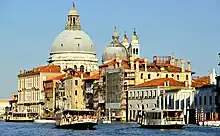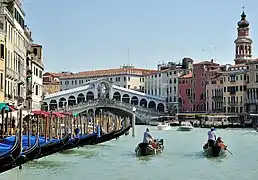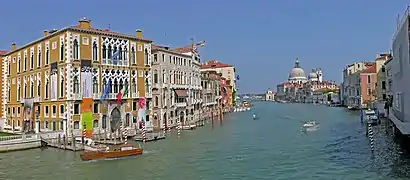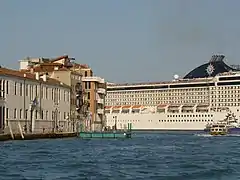Canal Grande | |
|---|---|
| Canal | |
 The Grand Canal looking south from Rialto Bridge | |
| Location | Venice, Italy |
Click the map for an interactive, fullscreen view. | |
The Grand Canal (Italian: Canal Grande [kaˌnal ˈɡrande]; Venetian: Canałaso rarely Canal Grando) is a channel in Venice, Italy. It forms one of the major water-traffic corridors in the city.
One end of the canal leads into the lagoon near the Santa Lucia railway station and the other end leads into the basin at San Marco; in between, it makes a large reverse-S shape through the central districts (sestieri) of Venice. It is 3.8 km (2.4 mi) long, and 30 to 90 m (98 to 295 ft) wide, with an average depth of 5 metres (16 feet).
Description
The banks of the Grand Canal are lined with more than 170 buildings, most of which date from the 13th to the 18th century, and demonstrate the welfare and art created by the Republic of Venice. The noble Venetian families faced huge expenses to show off their richness in suitable palazzos; this contest reveals the citizens’ pride and the deep bond with the lagoon. Amongst the many are the Palazzi Barbaro, Ca' Rezzonico, Ca' d'Oro, Palazzo Dario, Ca' Foscari, Palazzo Barbarigo and to Palazzo Venier dei Leoni, housing the Peggy Guggenheim Collection.[1] The churches along the canal include the basilica of Santa Maria della Salute. Centuries-old traditions, such as the Historical Regatta, are perpetuated every year along the Canal.
Because most of the city's traffic goes along the Canal rather than across it, only one bridge crossed the canal until the 19th century, the Rialto Bridge. There are currently three more bridges, the Ponte degli Scalzi, the Ponte dell'Accademia, and the controversial Ponte della Costituzione from 2008, designed by Santiago Calatrava, connecting the train station to Piazzale Roma, one of the few places in Venice where buses and cars can enter. As was usual in the past, people can still take a ferry ride across the canal at several points by standing up on the deck of a simple gondola called a traghetto, although this service is less common than even a decade ago.
Most of the palaces emerge from water without pavement. Consequently, one can only tour past the fronts of the buildings on the grand canal by boat.
History
The first settlements
The Grand Canal probably follows the course of an ancient river (possibly a branch of the Brenta) flowing into the lagoon. Adriatic Veneti groups already lived beside the formerly-named "Rio Businiacus" before the Roman age. They lived in stilt houses and relied on fishing and commerce (mainly salt). Under the rule of the Roman empire and later of the Byzantine empire the lagoon became populated and important, and in the early 9th century the doge moved his seat from Malamocco to the safer "Rivoaltus".
Increasing trade followed the doge and found in the deep Grand Canal a safe and ship accessible canal-port. Drainage reveals that the city became more compact over time: at that time the Canal was wider and flowed between small, tide-subjected islands connected by wooden bridges.
"Fondaco" houses
Along the Canal, the number of "fondaco" houses increased, buildings combining the warehouse and the merchant's residence.
A portico (the curia) covers the bank and facilitates the ships' unloading. From the portico a corridor flanked by storerooms reaches a posterior courtyard. Similarly, on the first floor a loggia as large as the portico illuminates the hall into which open the merchant's rooms. The façade is thereby divided into an airy central part and two more solid sides. A low mezzanine with offices divides the two floors.
The fondaco house often had lateral defensive towers (torreselle), as in the Fondaco dei Turchi (13th century, heavily restored in the 19th). With the German warehouse, the Fondaco dei Tedeschi (which is also situated on the Grand Canal), it reflects the high number of foreign merchants working in Venice, where the republic supplied them with storerooms and lodging and simultaneously controlled their trading activity.
More public buildings were built along the Canal at Rialto: palaces for commercial and financial Benches (Palazzo dei Camerlenghi and Palazzo dei Dieci Savi, rebuilt after 1514 fire) and a mint. In 1181 Nicolò Barattieri constructed a pontoon bridge connecting Rialto to Mercerie area, which was later replaced by a wooden bridge with shops on it. Warehouses for flour and salt were more peripheral.
The Venetian-Byzantine style
From the Byzantine empire, goods arrived together with sculptures, friezes, columns and capitals to decorate the fondaco houses of patrician families. The Byzantine art merged with previous elements resulting in a Venetian-Byzantine style; in architecture, it was characterized by large loggias with round or elongated arches and by polychrome marbles abundance.
Along the Grand Canal, these elements are well preserved in Ca' Farsetti, Ca' Loredan (both municipal seats) and Ca' da Mosto, all dating back to the 12th or 13th century. During this period Rialto had an intense building development, determining the conformation of the Canal and surrounding areas. As a matter of fact, in Venice building materials are precious and foundations are usually kept: in the subsequent restorations, existing elements will be used again, mixing the Venetian-Byzantine and the new styles (Ca' Sagredo, Palazzo Bembo). Polychromy, three-partitioned façades, loggias, diffuse openings, and rooms disposition formed a particular architectural taste that continued in the future.
The Fourth Crusade, with the loot obtained from the sack of Constantinople (1204), and other historical situations, gave Venice an Eastern influence until the late 14th century.
Venetian Gothic
Venetian Gothic architecture found favor quite late, as a splendid flamboyant Gothic ("gotico fiorito") beginning with the southern façade of the Doge's Palace. The verticality and the illumination characterizing the Gothic style are found in the porticos and loggias of fondaco houses: columns get thinner, elongated arches are replaced by pointed or ogee or lobed ones. Porticos rise gently intertwining and drawing open marbles in quatrefoils or similar figures. Façades were plastered in brilliant colors.
The open marble fascias, often called "laces", quickly diffused along the Grand Canal. Among the 15th-century palaces still showing the original appearance are Ca' d'Oro, Palazzo Bernardo a San Polo, Ca' Foscari (now housing the University of Venice), Palazzo Pisani Moretta, Palazzi Barbaro, Palazzo Cavalli-Franchetti.[1][2]
Renaissance
By the start of the 15th century, Renaissance architecture motifs appear in such buildings as the Palazzo Dario and the Palazzo Corner Spinelli; the latter was designed by Mauro Codussi, pioneer of this style in Venice. Ca' Vendramin Calergi, another of his projects (now hosting the Casino), reveals a completed transition: the numerous and large windows with open marbles are round-arched and have columns in the three classical orders.
Classical architecture is more evident in Jacopo Sansovino's projects, who arrived from Rome in 1527. Along the Canal, he designed Palazzo Corner and Palazzo Dolfin Manin, known for grandiosity, for the horizontal layout of the white façades and for the development around a central courtyard. Other Renaissance buildings are Palazzo Papadopoli and Palazzo Grimani di San Luca. Several palaces of this period had façades with frescoes by painters such as Il Pordenone, Tintoretto, Paolo Veronese, all of them unfortunately lost. Particularly noteworthy were the frescoes by Veronese and Zelotti on Ca Cappello, overlooking the Grand Canal at the intersection with the Rio de S. Polo.
Venetian Baroque
In 1582, Alessandro Vittoria began the construction of Palazzo Balbi (now housing the Government of Veneto), in which Baroque elements can be recognized: fashioned cornices, broken pediments, ornamental motifs.
The major Baroque architect in Venice was Baldassarre Longhena. In 1631 he began to build the magnificent Santa Maria della Salute basilica, one of the most beautiful churches in Venice and a symbol of Grand Canal. The classical layout of the façade features decorations and by many statues, the latter crowning also the refined volutes surrounding the major dome.
Longhena later designed two majestic palaces, Ca' Pesaro and Ca' Rezzonico (with many carvings and chiaroscuro effects), and Santa Maria di Nazareth church (Chiesa degli Scalzi). For various reasons the great architect did not see any of these buildings finished, and the designs for all but Santa Maria Della Salute were modified after his death.
Longhena's themes recur in the two older façades of Palazzo Labia, containing a famous fresco cycle by Giambattista Tiepolo. In the Longhenian school grew Domenico Rossi (San Stae's façade, Ca' Corner della Regina) and Giorgio Massari, who later completed Ca' Rezzonico.
The 16th and 17th centuries mark the beginning of the Republic's decline, but nevertheless, they saw the highest building activity on the Grand Canal. This can be partially explained by the increasing number of families (like the Labia) becoming patrician by the payment of an enormous sum to the Republic, which was then facing financial difficulties. Once these families had achieved this new status, they built themselves with impressive residences on the Canal, often inducing other families to renew theirs.
Neoclassical architecture
Neoclassical architectures along the Canal date to the 18th century: during the first half was built San Simeone Piccolo, with an impressive corinthian portico, central plan and a high copper-covered dome ending in a cupola shaped as a temple. Date to the second half Massari's Palazzo Grassi.
Modern era

After the fall of the Republic of Venice in 1797, much of the palatial construction in Venice was suspended, as symbolized by the unfinished San Marcuola and Palazzo Venier dei Leoni (housing the Peggy Guggenheim Collection). The Patrician families, bereft of their hereditary role in governance and sometimes persecuted by revolutionary forces, sought other residences. Several historical palaces were pulled down, but many found other uses, and some restorations have saved their 18th-century appearance. By the late 20th century, most of the more prominent palaces were owned by the city, state, or civic institutions.

During the era of the Napoleonic Kingdom of Italy, the Napoleonic suppression of the monastic religious orders vacated large sectors of real estate in the city. It also freed large amounts of furnishings and works of art into the antiquarian market or into the possession of the state. Large monasteries changed functions: the Santa Maria della Carità complex became a museum, the Gallerie dell'Accademia); the Santa Croce complex, was converted into the Papadopoli Gardens area; and the Santa Lucia complex (partially designed by Palladio) was razed for the establishment of the Santa Lucia Station.
The Kingdom of Italy accession restored serenity in the city and stimulated construction along the Grand Canal respecting its beauty, often reproduced in Gothic Revival architectures like the Pescaria at Rialto.
Events

Historical Regatta
On the first Sunday of September the Historical Regatta ("Regata Storica") takes place, a competition between Venetian boats watched by thousands of people from the banks or from floating stands.[3] Competitions are preceded by a historical procession ("Corteo Storico") remembering the entrance of the Queen of Cyprus Catherine Cornaro after abdication in 1489: gondoliers in costumes sail in typical 16th century boats following the Bucentaur, doge's state galley.[4]
The Feast-day of the Madonna della Salute
On November 21, Venetians thank the Virgin Mary for salvation from the plague epidemic in 1630-38 with a pilgrimage to Santa Maria della Salute. Pilgrims cross Grand Canal on a temporary pontoon bridge from Campo Santa Maria del Giglio, and enjoy stalls and traditional dishes.[5]
Gallery
 Two gondoliers pull out with clients on board from a row of gondolas on the Grand Canal near the Rialto Bridge
Two gondoliers pull out with clients on board from a row of gondolas on the Grand Canal near the Rialto Bridge The Grand Canal from Ponte dell'Accademia; in the foreground Palazzo Cavalli-Franchetti, in the distance Santa Maria della Salute
The Grand Canal from Ponte dell'Accademia; in the foreground Palazzo Cavalli-Franchetti, in the distance Santa Maria della Salute The Grand Canal in Venice, Italy, shot at night from Rialto Bridge
The Grand Canal in Venice, Italy, shot at night from Rialto Bridge The Grand Canal in Venice from Palazzo Flangini to Campo San Marcuola, Canaletto, about 1738. The J. Paul Getty Museum, Los Angeles
The Grand Canal in Venice from Palazzo Flangini to Campo San Marcuola, Canaletto, about 1738. The J. Paul Getty Museum, Los Angeles Ocean ship entering Grand Canal
Ocean ship entering Grand Canal
See also
- List of buildings and structures in Venice
- Republic of Venice
- Grand Canal (Venice) architecture for listing and identification of buildings along the canal
References
- 1 2 Imagiamedia.ca. "Venetian Palaces of the Grand Canal - Panoram Italia". www.panoramitalia.com. Archived from the original on 5 May 2018. Retrieved 5 May 2018.
- ↑ "Venice and its lagoons :: Gothic style". www.venicethefuture.com. Archived from the original on 8 June 2016. Retrieved 5 May 2018.
- ↑ "Regata Storica is The Spectacle to See". Ikon London Magazine. 10 September 2016. Archived from the original on 6 March 2018. Retrieved 23 February 2018.
- ↑ Flamming-Lab. "Regata Storica di Venezia - Official Website". www.regatastoricavenezia.it. Archived from the original on 26 December 2017. Retrieved 5 May 2018.
- ↑ "Festa Della Salute celebrates Feast of our Lady of Health". veniceXplorer. Archived from the original on 13 September 2022. Retrieved 13 September 2022.
Sources
- A. Zorzi, P. Marton I Palazzi Veneziani – Magnus Ed., Udine 1989; ISBN 88-7057-083-5
- M. Brusegan La grande guida dei monumenti di Venezia - Newton & Compton Ed., Roma 2005; ISBN 88-541-0475-2.
- E. e W. Eleodori Il Canal Grande. Palazzi no' – Corbo e Fiore Editori, II ed., Venezia 2007; ISBN 88-7086-057-4.
- Guida d'Italia – Venezia. 3a ed. Milano, Touring Editore, 2007. ISBN 978-88-365-4347-2.
- Alvise Zorzi, P. Marton. I Palazzi Veneziani. Udine, Magnus, 1989. ISBN 88-7057-083-5.
- Venezia e provincia. Milano, Touring Editore, 2004. ISBN 88-365-2918-6.
- Raffaella Russo. Palazzi di Venezia. Venezia, Arsenale Ed., 1998. ISBN 88-7743-185-7.
- Umberto Franzoi, Mark Smith. Canal Grande. Venezia, Arsenale Ed., 1993. ISBN 88-7743-131-8.
- Giuseppe Mazzariol (a cura di). I Palazzi del Canal Grande. Novara, Istituto Geografico De Agostini, 1989.
- Gianjacopo Fontana. Venezia monumentale - I Palazzi. Venezia, Filippi Ed., 1967.
- Andrea Fasolo, Mark Smith. Palazzi di Venezia. Venezia, Arsenale Ed., 2003. ISBN 88-7743-295-0.
- The Art and Architecture of Venice
- Terisio Pignatti (a cura di). Le scuole di Venezia. Milano, Electa, 1981.
- Silvia Gramigna, Annalisa Perissa. Scuole di Arti, Mestieri e Devozione a Venezia. Venezia, Arsenale Coop
- Giuseppe Tassini. Curiosità Veneziane. Venezia, Filippi Ed., 2001.
External links
| Preceded by Gallerie dell'Accademia |
Venice landmarks Grand Canal |
Succeeded by Piazza San Marco |




